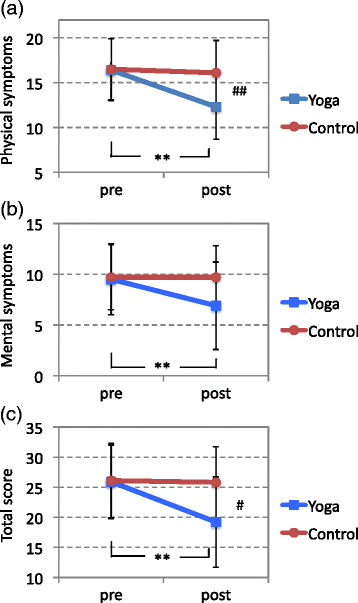Isometric yoga improves the fatigue and pain of patients with chronic fatigue syndrome who are resistant to conventional therapy: a randomized, controlled trial
- PMID: 25525457
- PMCID: PMC4269854
- DOI: 10.1186/s13030-014-0027-8
Isometric yoga improves the fatigue and pain of patients with chronic fatigue syndrome who are resistant to conventional therapy: a randomized, controlled trial
Abstract
Background: Patients with chronic fatigue syndrome (CFS) often complain of persistent fatigue even after conventional therapies such as pharmacotherapy, cognitive behavioral therapy, or graded exercise therapy. The aim of this study was to investigate in a randomized, controlled trial the feasibility and efficacy of isometric yoga in patients with CFS who are resistant to conventional treatments.
Methods: This trial enrolled 30 patients with CFS who did not have satisfactory improvement after receiving conventional therapy for at least six months. They were randomly divided into two groups and were treated with either conventional pharmacotherapy (control group, n = 15) or conventional therapy together with isometric yoga practice that consisted of biweekly, 20-minute sessions with a yoga instructor and daily in-home sessions (yoga group, n = 15) for approximately two months. The short-term effect of isometric yoga on fatigue was assessed by administration of the Profile of Mood Status (POMS) questionnaire immediately before and after the final 20-minute session with the instructor. The long-term effect of isometric yoga on fatigue was assessed by administration of the Chalder's Fatigue Scale (FS) questionnaire to both groups before and after the intervention. Adverse events and changes in subjective symptoms were recorded for subjects in the yoga group.
Results: All subjects completed the intervention. The mean POMS fatigue score decreased significantly (from 21.9 ± 7.7 to 13.8 ± 6.7, P < 0.001) after a yoga session. The Chalder's FS score decreased significantly (from 25.9 ± 6.1 to 19.2 ± 7.5, P = 0.002) in the yoga group, but not in the control group. In addition to the improvement of fatigue, two patients with CFS and fibromyalgia syndrome in the yoga group also reported pain relief. Furthermore, many subjects reported that their bodies became warmer and lighter after practicing isometric yoga. Although there were no serious adverse events in the yoga group, two patients complained of tiredness and one of dizziness after the first yoga session with the instructor.
Conclusions: Isometric yoga as an add-on therapy is both feasible and successful at relieving the fatigue and pain of a subset of therapy-resistant patients with CFS.
Trial registration: University Hospital Medical Information Network (UMIN CTR) UMIN000009646.
Keywords: Chronic fatigue syndrome; Fatigue; Fibromyalgia; Isometric yoga; Treatment.
Figures




References
-
- White PD, Goldsmith KA, Johnson AL, Potts L, Walwyn R, DeCesare JC, Baber HL, Burgess M, Clark LV, Cox DL, Bavinton J, Angus BJ, Murphy G, Murphy M, O'Dowd H, Wilks D, McCrone P, Chalder T, Sharpe M. Comparison of adaptive pacing therapy, cognitive behaviour therapy, graded exercise therapy, and specialist medical care for chronic fatigue syndrome (PACE): a randomised trial. Lancet. 2011;377:823–836. doi: 10.1016/S0140-6736(11)60096-2. - DOI - PMC - PubMed
LinkOut - more resources
Full Text Sources
Other Literature Sources

